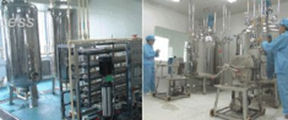Southern ginseng-Jiaogulan - Extract powders
Processing
The Gynostemma pentaphyllum shrub is not a member from the Araliaceae family and is therefore not a real ginseng. Because some adaptogene actions are comparable with those from real ginseng, it is also called Southern Ginseng or Women's Ginseng.Unlike real ginseng, not the roots but the aerial parts of the Jiaogulan plant are used.
Both the leaves and stems are harvested and dried. After drying the Jiaogulan goes into a carefully controlled extraction process with the desired concentration of gypenosides as a result.
Because some gypenosides only dissolve in water and others only in alcohol, a particular mixture of alcohol and water is used for extraction.
 |
A highly controlled processing method ensures that the dry Jiaogulan leaves and stems are processed into extract powders according approved standard processes. |
After extraction the alcohol is distilled from the liquid extract. Then the liquid extract is dried into an extract powder. This standard process ensures a Jiaogulan extract powder that contains minimal 80% gypenosides (HPLC).
Composition of extract powders
Jiaogulan extract powders are only made from the aerial parts of the plant.Apart from some exceptions, almost all basic Jiaogulan extract powders are made without carriers or additives. At a customer's request a desired additive can still be added.
Packaging
For amounts less than 25 kg, Jiaogulan extract powders are packed per 1 kg in airtight aluminum bags with PE-inner layer. Bags with 5 kg are also available.Larger bulk quantities are packed in standard plastic bags in cardboard boxes or barrels.
Properties
Regular Jiaogulan extract powders hardly dissolve in water. With some adjustments in the production process it is possible to make extract powders that dissolve very well in water.The color of the powder is brown to yellow-brownish.
The taste of regular Jiaogulan extract powder can be qualified as penetrating taste, it is bitter, a bit wry and certainly not tasty. As the level of gypenosides rises, the root's bitter taste intensifies.
For some purposes the bitter taste of Jiaogulan is not desired. There are ways to decrease the intensity of the bitter taste.
A possible practical disadvantage from Jiaogulan extract powders is that they are quite hygroscopic: they easy attract moisture from the air. When not preserved the right way the powder is at a high risk of clotting together. Keeping it dry in closed packaging is therefore vital.
Additives
To reduce the costs of the extract powder, adding filler is an option. The cheapest filler is ground rice flour.For technical and sometimes taste sensory reasons also other possible additives like: dicalcium phosphate, malto dextrin, silicon dioxide, magnesium stearate or glucose powder are used. Of course other additives, carriers or fillers are possible too.
Another benefit of adding filler to the extract powder is that it can drastically decrease the hygroscopic nature of the product.
Dosage
Based on long term use of Jiaogulan it can be considered as being safe to use even in high dosage. No maximum intake dosage has been set.For optimal therapeutic results of Jiaogulan extract powders it is advised to take 30-60 mg pure gypenosides daily.
For a Jiaogulan extract powder with for example 80% gypenosides this means a daily intake of 40-80 mg of extract powder per day.
The dried herb contains about 5% gypenosides, which results in an optimal therapeutic dose of 600-1200 mg powder per day.
Practical experiences have demonstrated that activity and effects of Jiaogulan do not decline proportionally as a daily dose is lowered.
There is no dangerous (damaging) maximum daily dose, but 5-10 mg of pure gypenosides should be considered as a minimal dose. If you take less than this dosage a day it will most likely not contribute anything.
When mixed with other medicinal herbs, a lower dose of Jiaogulan might be sufficient.
 |
 |
| previous | next |
